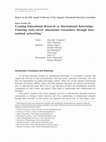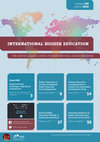Papers by AKIYOSHI YONEZAWA
The Impact of Covid-19 on the Institutional Fabric of Higher Education
The Polish and Russian higher education (HE) systems evolved from similar semi-peripheral positio... more The Polish and Russian higher education (HE) systems evolved from similar semi-peripheral positions and centralist administration into networks of actors whose collective but uncoordinated efforts steered the internationalisation of HE. However, it all was interrupted by the outbreak of the COVID-19 pandemic that opened doors to new policy actors largely unrelated to HE with their own agenda who do not recognise the exceptional status of HE, downplaying the institutional autonomy of universities and ignoring the fact that internationalisation lies at the core of the academy. This chapter examines changes in the topography of HE policy in both countries and discusses the short- and long-term impact of the pandemic on the internationalisation of HE.
Student and Skilled Labour Mobility in the Asia Pacific Region

Educational Studies in Japan
To develop education research as international knowledge, it is essential to nurture and support ... more To develop education research as international knowledge, it is essential to nurture and support the activities of the next-generation and early-career education researchers who will bear the responsibility for global knowledge creation. What role can the Japanese Educational Research Association (JERA), along with other Japanese education associations and networks, play in achieving this goal? How can we use education societies and international academic communities in each country and region? What kinds of partnerships and collaborations are desirable? This panel's speakers have been engaged actively in international education research communities in Europe, North America, and Asia, contributing to international research through these networks. In this session, the panelists will discuss how to help Japan's moti-This Research Session was conducted in English (with simultaneous interpretation into Japanese) under the auspices of the International Exchange Committee. The reports of Research Session I and II can be found in the Japanese journal Kyoikugaku Kenkyu.
The rise of East Asian knowledge economies has driven national leaders and higher education resea... more The rise of East Asian knowledge economies has driven national leaders and higher education researchers to seek identities for their own universities and higher education systems. This trend may, in the end, lead to a crisis of the identity that universities have in common, as autonomous academic bodies
Asian Economic Policy Review
The Journal of Science Policy and Research Management, 2014
Reimagining Education: The International Science and Evidence based Education Assessment
Managing International Connectivity, Diversity of Learning and Changing Labour Markets, 2016
Although the relationship between cities and universities is a commonly discussed topic, the so-c... more Although the relationship between cities and universities is a commonly discussed topic, the so-called world-class universities and global cities in East Asia do not always fit into one single cosmopolitan model. Focusing on the case of Tokyo and Japan, the authors of this chapter examine the mobility patterns, academic and social lives, and gender differences of university academics as representative knowledge workers. Using original survey results, the authors initially create a hierarchical structure of academic mobility patterns in Japan and subsequently argue that Tokyo, as the capital of Japan, is a centre of intellectual network through its education and training function.
The Governance and Management of Universities in Asia, 2019
Research Handbook on University Rankings, 2021

When a global health crisis renders mobility impossible, making all universities de facto isolate... more When a global health crisis renders mobility impossible, making all universities de facto isolated and remote, researchers should look at ways to redefine and generalize internationalization while removing the exclusive focus on mobility. Learning from the “unusual suspects” of internationalization—i.e., institutions that were considered remote before the crisis—is a unique opportunity to move the focus away from student mobility and foster more sustainable and inclusive internationalization practices. 10 N U M B E R 1 0 8 _A U t U M N 2 0 2 1 COVID-19 IMPLICATIONS | INtERNAtIONAL HIGHER EDUCAtION Never Let a Good Crisis Go to Waste When a global pandemic was declared in March 2020, Altbach and de Wit called COVID-19 “the internationalization revolution that isn’t.” One and a half years later, their expectation that the corona crisis would not bring about dramatic medium-term transformations in higher education has been confirmed. Governments and universities are basically waiting i...
Journal of Higher Education Policy and Management, 2019
Towards the Private Funding of Higher Education, 2017
Higher education research in Asia is undergoing significant changes, but limited yet in terms of ... more Higher education research in Asia is undergoing significant changes, but limited yet in terms of research community, active researchers, research themes and methodologies. This chapter introduces the book Researching Higher Education in Asia: History, Development and Future, which aims to explore the evolution of higher education research as a field of study in Asia using a historical, theoretical and empirical approach. It further aims to extend the research scope beyond the more studied East Asian countries to incorporate Southeast Asian, South Asian and Central Asian countries. An overarching framework that relates to main issues under discussion in the region in terms of higher education research is presented in the introduction, followed by 14 country cases from different Asia regions describing the dynamics of higher education research in each individual country.
Japan achieved mass higher education very early even compared to other developed countries. The s... more Japan achieved mass higher education very early even compared to other developed countries. The share of youth enrolled in higher education exceeded 15% in 1963, 50% by 1978, and was 79.8% in 2016. These data include enrollments in the newly established non-university, postsecondary sector, according to the School Basic Survey that the Ministry of Education, Culture, Sports, Science, and Technology (MEXT) carries out every year.
EJ626652 - Changing Higher Education Policies for Japanese National Universities.











Uploads
Papers by AKIYOSHI YONEZAWA